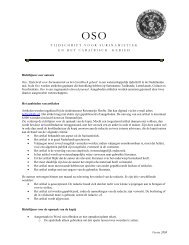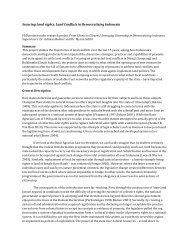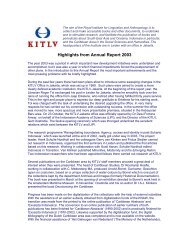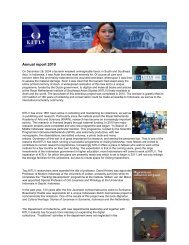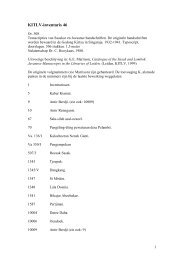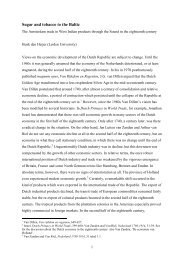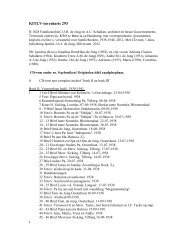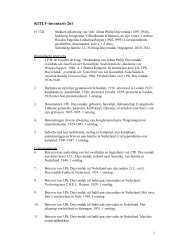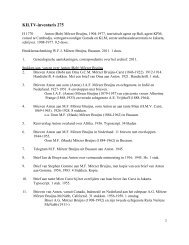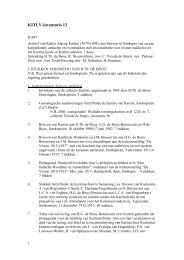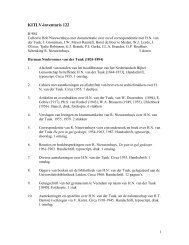The Acehnese past and its present state of study R. Michael ... - kitlv
The Acehnese past and its present state of study R. Michael ... - kitlv
The Acehnese past and its present state of study R. Michael ... - kitlv
Create successful ePaper yourself
Turn your PDF publications into a flip-book with our unique Google optimized e-Paper software.
<strong>The</strong> <strong>Acehnese</strong> <strong>past</strong> <strong>and</strong> <strong>its</strong> <strong>present</strong> <strong>state</strong> <strong>of</strong> <strong>study</strong> 15<br />
<strong>The</strong> period <strong>of</strong> the Dutch wars in Aceh (1873-1942) is undoubtedly the<br />
most heavily documented <strong>and</strong> discussed period <strong>of</strong> the region’s history. 21 <strong>The</strong><br />
Dutch invasion <strong>and</strong> continuing campaigns to establish control over Aceh<br />
had a pr<strong>of</strong>ound effect on the development <strong>of</strong> <strong>Acehnese</strong> society. One <strong>of</strong> the<br />
most fundamental transformations was in the way that Dutch intervention<br />
reconfi gured relations between ulèëbalang <strong>and</strong> ulama (Snouck Hurgronje 1906,<br />
I: 187). 22 <strong>The</strong> prolonged confl ict left deep scars on both the <strong>Acehnese</strong> <strong>and</strong> the<br />
Dutch well beyond the horrendous casualties <strong>of</strong> the battlefi elds, <strong>and</strong> in many<br />
ways the experience was formative on the development <strong>of</strong> the respective<br />
cultural dynamics on both sides since the turn <strong>of</strong> the twentieth century<br />
(Illustration 5). For the Dutch, it made a deep impact on domestic visions<br />
<strong>of</strong> Islam <strong>and</strong> the colonial encounter that continue to inform contemporary<br />
discourses. 23 For the <strong>Acehnese</strong>, the legacies <strong>of</strong> confl ict, both during <strong>and</strong> since<br />
the wars against the Dutch, have fostered popular perceptions <strong>and</strong> even selfascriptions<br />
<strong>of</strong> Aceh’s history as pre-eminently one <strong>of</strong> violence, as well as the<br />
establishment <strong>of</strong> the idea <strong>of</strong> ‘resistance’ as a key concept in the formation <strong>of</strong><br />
<strong>Acehnese</strong> identity. 24<br />
On a more concrete level, the Dutch wars in Aceh were responsible for<br />
dramatic cultural innovations facilitated by a range <strong>of</strong> new elements introduced<br />
to the region during the confl ict. <strong>The</strong>se included European, Chinese<br />
<strong>and</strong> Javanese immigrants who brought with them their own cultural practices<br />
<strong>and</strong> material artefacts, while also introducing the latest technologies <strong>of</strong> both<br />
battle <strong>and</strong> bourgeois <strong>past</strong>imes to the region. Of particular importance for historical<br />
documentation was the camera, which captured many military, public<br />
<strong>and</strong> domestic scenes around Aceh during the late nineteenth <strong>and</strong> early twentieth<br />
centuries.<br />
Jean Gelman Taylor’s chapter in this volume introduces the Images Archive<br />
<strong>of</strong> the Koninklijk Instituut voor Taal-, L<strong>and</strong>- en Volkenkunde (KITLV, Royal<br />
Netherl<strong>and</strong>s Institute <strong>of</strong> Southeast Asian <strong>and</strong> Caribbean Studies) as a resource<br />
21 Indeed, new sources for the history <strong>of</strong> the Aceh War continue to be brought to light, most<br />
recently with the translation <strong>of</strong> edited excerpts from the account <strong>of</strong> a Czech physician in the service<br />
<strong>of</strong> the Dutch invasion force (Durdik 2009).<br />
22 Snouck Hurgronje is <strong>of</strong>ten credited (or castigated) as central in making this division crucial<br />
to shaping the contours <strong>of</strong> the Dutch wars in Aceh. For Snouck’s own <strong>state</strong>ments on the religious<br />
<strong>and</strong> social dynamics <strong>of</strong> Aceh in this context, see Gobée <strong>and</strong> Adriaanse 1957:47-396.<br />
23 As attested to by the sustained resonance <strong>of</strong> echoes <strong>of</strong> popular Dutch works, <strong>and</strong> their Indonesian<br />
translations, including Zentgraaf 1938, <strong>and</strong> Van’t Veer 1969.<br />
24 It is curious that other cultures in Indonesia that took to displays <strong>of</strong> dramatic violence in<br />
the face <strong>of</strong> Dutch colonial expansion at the turn <strong>of</strong> the twentieth century have elected not to foreground<br />
this as formative <strong>of</strong> their cultural identity. An example would be puputan in Bali, where<br />
horrifi c incidents <strong>of</strong> religiously-inspired wartime martyrdom <strong>and</strong> subsequent outbursts <strong>of</strong> violence,<br />
such as during the 1965 killings, are effectually ‘erased’ from cultural memory in creating<br />
an identity emphasizing tolerance <strong>and</strong> harmony.




